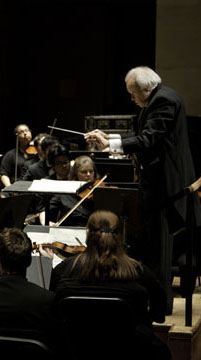The reviews are in: ‘Meadows at the Winspear’ was 'exhilarating'
"Meadows at the Winspear" receives an excellent review by Dallas Morning News Classical Music Critic Scott Cantrell.
From The Dallas Morning News
The following review by Classical Music Critic Scott Cantrell appeared in the May 2, 2013, edition of The Dallas Morning News.
Scott Cantrell
Classical Music Critic
The Dallas Morning News
Every once in a while, usually when you least expect it, a “mere” performance widens your eyes and quickens your heartbeat and respiration. That’s how it was with Wednesday night’s “Meadows at the Winspear” program at the Winspear Opera House.
Long an annual showcase for SMU’s excellent Meadows Symphony Orchestra, the annual fundraising event has sometimes added performances by choral and dance programs at the Meadows School of the Arts. This 20th installment had the Meadows Dance Ensemble onstage in four works, all accompanied by the Meadows Symphony in the pit.

New choreography by Joost Vrouenraets for The Rite of Spring replaced the original 1913 scenario of ritual sacrifice in pagan Russia with a modern drama of desperation, terror, cleansing and final defiance. Deconstructed, spun around and reassembled, designer Russell Parkman’s complex of Plexiglas mini-houses served alternately as confinement and protection. Steve Woods worked wonders with lights.
Costumer Eugenia P. Stallings dressed the substantial corps of dancers as a tribal force for today: uniformed prep-school kids. Movements were angular, athletic, at times desperate, and performed with fearless abandon. Part One ended with the whole ensemble lined up across the stage apron, as if facing something horrible, in what seemed an interminable silence.
In Part Two, a sinister little metal puppet, manipulated by five men, menaced then discarded one woman after another. Finally, though, the Chosen One, danced brilliantly and full-out by Julie Kaye, dared to fight off the advances and finally triumphed.
One now usually hears Stravinsky’s score polished into an orchestral showpiece. Phillips, by contrast, dug into its sheer weirdness and savagery. It wasn’t always the sleekest performance, but it was hair-raising — and probably closer to what Stravinsky originally had in mind.
A duet from Adam Hougland’s Watershed, fluently executed by Raven Ross and Dexter Green, was a study in liquescent suspensions and clutchings — paralleling those of the achingly beautiful Sarabande from Chrisopher Rouse’s Friandises. Soloists Aubry Neal and Alex Druzbanski and an ensemble of four women demonstrated fine classical ballet training in Balanchine’s Valse fantaisie, to a gently sprung waltz by Glinka.
Danny Buraczeski’s In the City, to Three Dance Episodes from Bernstein’s On the Town, was generic urban exuberance and atmosphere, with the women in bright dresses, the men in khakis and plaid shirts. Stylized projections of downtown Dallas buildings added a nice touch.
Start to finish, this was an exhilarating evening. But next year, let’s give the spotlight back to the Meadows Symphony, at the Meyerson Symphony Center.